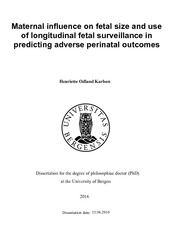| dc.contributor.author | Karlsen, Henriette Odland | en_US |
| dc.date.accessioned | 2016-08-25T08:12:47Z | |
| dc.date.available | 2016-08-25T08:12:47Z | |
| dc.date.issued | 2016-06-15 | |
| dc.identifier.isbn | 978-82-308-3301-8 | en_US |
| dc.identifier.uri | https://hdl.handle.net/1956/12678 | |
| dc.description.abstract | Background: Fetal growth is influenced by maternal factors, but also more specifically determined by level of fetoplacental circulation. We tested the hypothesis that fetal abdominal circumference (AC) in the second trimester was influenced by maternal weight gain during pregnancy. Further, we investigated whether fetal growth assessment using serial measurements, i.e. conditional centiles for estimated fetal weight (EFW), improved the prediction of perinatal outcomes in a population at high risk of having small for gestational age (SGA) fetuses. Similarly, we tested the use of conditional centiles for the middle cerebral artery (MCA) pulsatility index (PI) and the cerebroplacental ratio (CPR). Material and method: In study I data from the «Fetal age and growth» study that included healthy pregnant women, were used to examine the effect of maternal weight gain on fetal AC at gestational week 15-25. Z-scores were used in a linear regression analysis. In study II and III pregnant women at risk of, or diagnosed with an SGA (≤5th centile) fetus were included for serial ultrasound measurements of fetal size and Doppler. In both studies data from the final two examinations were included in a regression analysis. Adverse outcomes were birth <37 weeks, operative delivery due to fetal distress, 5-min Apgar score <7, neonatal hypoglycemia (glucose <2.0 mmol/L), admission to the neonatal intensive care unit, and perinatal mortality. Results: Study I: Complete data were available in 515 of the 650 included women. We found a positive association between z-score for weekly maternal weight gain and zscore for second trimester fetal AC (p = 0.001). Study II and III: Complete biometric data were obtained for 211 women and serial Doppler measurements were available in 207 participants. Combining conditional and conventional centiles of EFW ≤5 and ≤10 (Study II) and CPR ≤10 (Study III) significantly improved the prediction of adverse outcomes compared with conventional centiles for EFW and CPR alone. Conclusions: Study I: Maternal weight gain in pregnancy is positively associated with fetal AC in second trimester. This study adds information that fetal growth regulation can be traced already in second trimester. Study II and III: The use of conditional centiles for EFW and CPR in combination with conventional centiles improved prediction of adverse perinatal outcomes. The results support an increased use of conditional growth centiles in the monitoring of fetuses at risk, while the large individual physiological variation in CPR may limits the test performance. In general, our results indicate that there is merit in the further development of using serial observations to improve the prediction of adverse perinatal outcomes. | en_US |
| dc.language.iso | eng | eng |
| dc.publisher | The University of Bergen | eng |
| dc.relation.haspart | Paper I: Hellebust H, Johnsen SL, Rasmussen S, Kiserud T. Maternal weight gain: determinant for fetal abdominal circumference at second trimester. Acta Obstet Gynecol Scand 2011 Jun: 90(6): 666-70. The article is available in the main thesis. The article is also available at: <a href="http://dx.doi.org/10.1111/j.1600-0412.2011.01129.x" target="blank">http://dx.doi.org/10.1111/j.1600-0412.2011.01129.x</a> | en_US |
| dc.relation.haspart | Paper II: Karlsen HO, Johnsen SL, Rasmussen S, Kiserud T. Prediction of adverse neonatal outcomes using size centiles and conditional growth centiles. Ultrasound Obstet Gynecol 2016 Aug: 48(2): 217-223. The article is available at: <a href="http://hdl.handle.net/1956/12679" target="blank">http://hdl.handle.net/1956/12679</a> | en_US |
| dc.relation.haspart | Paper III: Karlsen HO, Ebbing C, Rasmussen S, Kiserud T, Johnsen SL. Use of conditional centiles of middle cerebral artery pulsatility index and cerebroplacental ratio in the prediction of adverse perinatal outcomes. Acta Obstet Gynecol Scand 2016 Jun: 95(6): 690-696. The article is available at: <a href="http://hdl.handle.net/1956/12680" target="blank">http://hdl.handle.net/1956/12680</a> | en_US |
| dc.title | Maternal influence on fetal size and use of longitudinal fetal surveillance in predicting adverse perinatal outcomes | en_US |
| dc.type | Doctoral thesis | |
| dc.rights.holder | Copyright the Author. All rights reserved | |
| dc.identifier.cristin | 1372356 | |
